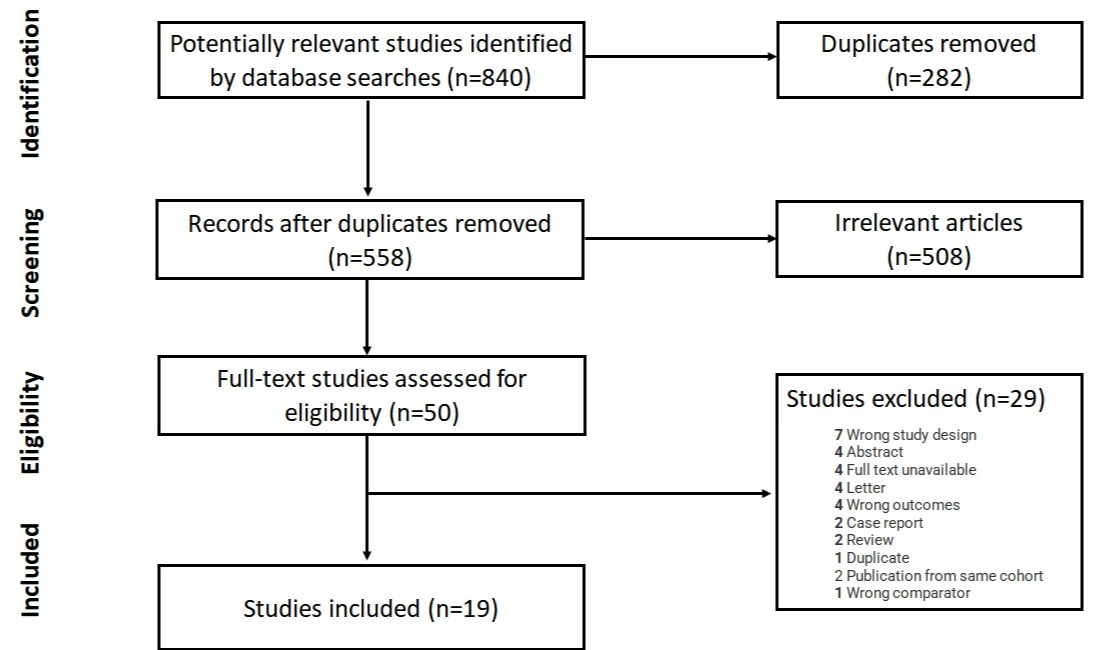Back
Poster Session D - Tuesday Morning
Category: Liver
D0511 - Porphyrias Are Linked to Primary Liver Cancer, Particularly Hepatocellular Carcinoma: A Systematic Review and Pooled Analysis
Tuesday, October 25, 2022
10:00 AM – 12:00 PM ET
Location: Crown Ballroom

Daryl Ramai, MD, MSc
University of Utah
Salt Lake City, UT
Presenting Author(s)
Daryl Ramai, MD, MSc1, Smit Deliwala, MD2, Saurabh Chandan, MD3, Janice Lester, MLS4, Jameel Singh, MD5, Jayanta Samanta, MBBS, MD, DM6, Rodolfo Sacco, MD7, Antonio Facciorusso, MD, PhD7
1University of Utah, Salt Lake City, UT; 2Michigan State University at Hurley Medical Center, Flint, MI; 3CHI Health Creighton School of Medicine, Omaha, NE; 4Long Island Jewish Medical Center, Long Island, NY; 5Mather Hospital, Long Island, NY; 6Post Graduate Institute of Medical Education and Research, Chandigarh, Chandigarh, India; 7University of Foggia, Foggia, Puglia, Italy
Introduction: Porphyrias are in-born defects in the heme biosynthesis pathway resulting in neurovisceral manifestations, cutaneous photosensitivity, and multi-systemic involvement. Its estimated prevalence nears 5 per 100,000 patients worldwide. Subclinical liver disease is common which carries a risk of malignancy. To this end, we aim to determine the risk of primary liver cancer and hepatocellular carcinoma (HCC) in patients with porphyria.
Methods: We conducted a comprehensive search of several databases, including PubMed, EMBASE, and Web of Science.We followed the Preferred Reporting Items for Systematic Reviews and Meta-Analyses (PRISMA) guidelines. Keywords used in the literature search included “porphyria,” “hepatic porphyria,” “delta-aminolevulinate-dehydratase deficiency porphyria,” “acute intermittent porphyria,” “porphyria cutanea tarda,” “cirrhosis,” “hepatocellular carcinoma,” “cancer,” “transplant,” to identify relevant articles.
Results: In total, 19 studies, which included 7,381 patients with porphyria (3476 females), were considered for the final review. In eight studies, alpha-fetoprotein levels were elevated between 200 and 1000 IU/ml. Elevated urinary delta-aminolevulinic acid dehydratase, prophobilinogen, and other uroporphyrins were observed. Median follow-up time ranged from 3 to 24 years. Of the total cohort of patients with porphyria, primary liver cancer was diagnosed in 351 patients (4.8%), of whom 243 (3.3% of the total) were found to have HCC. A small subset of patients was found to have cholangiocarcinoma (n=18; 0.3% of the total). Interestingly, progression to HCC was seen despite the development of advanced liver disease or cirrhosis. Of the total cohort, 30 patients underwent liver resection, 48 patients underwent liver transplantation, and 327 patients died. Compared to those who did not undergo periodic screening, only four patients (28.6%) underwent tumor resection with a recurrence rate of 75% (n=3/4).
Discussion: Our study revealed that patients with porphyria are at increased risk for the development of primary liver cancer and HCC. Furthermore, we showed that malignancy can occur even in the absence of cirrhosis, supporting the need for appropriate screening. To this end, AFP should be used in conjunction with imaging modalities to screen for liver malignancy as frequently as every 6–12 months. Further studies should aim to develop diagnostic and prognostic models aimed at its early detection.

Disclosures:
Daryl Ramai, MD, MSc1, Smit Deliwala, MD2, Saurabh Chandan, MD3, Janice Lester, MLS4, Jameel Singh, MD5, Jayanta Samanta, MBBS, MD, DM6, Rodolfo Sacco, MD7, Antonio Facciorusso, MD, PhD7. D0511 - Porphyrias Are Linked to Primary Liver Cancer, Particularly Hepatocellular Carcinoma: A Systematic Review and Pooled Analysis, ACG 2022 Annual Scientific Meeting Abstracts. Charlotte, NC: American College of Gastroenterology.
1University of Utah, Salt Lake City, UT; 2Michigan State University at Hurley Medical Center, Flint, MI; 3CHI Health Creighton School of Medicine, Omaha, NE; 4Long Island Jewish Medical Center, Long Island, NY; 5Mather Hospital, Long Island, NY; 6Post Graduate Institute of Medical Education and Research, Chandigarh, Chandigarh, India; 7University of Foggia, Foggia, Puglia, Italy
Introduction: Porphyrias are in-born defects in the heme biosynthesis pathway resulting in neurovisceral manifestations, cutaneous photosensitivity, and multi-systemic involvement. Its estimated prevalence nears 5 per 100,000 patients worldwide. Subclinical liver disease is common which carries a risk of malignancy. To this end, we aim to determine the risk of primary liver cancer and hepatocellular carcinoma (HCC) in patients with porphyria.
Methods: We conducted a comprehensive search of several databases, including PubMed, EMBASE, and Web of Science.We followed the Preferred Reporting Items for Systematic Reviews and Meta-Analyses (PRISMA) guidelines. Keywords used in the literature search included “porphyria,” “hepatic porphyria,” “delta-aminolevulinate-dehydratase deficiency porphyria,” “acute intermittent porphyria,” “porphyria cutanea tarda,” “cirrhosis,” “hepatocellular carcinoma,” “cancer,” “transplant,” to identify relevant articles.
Results: In total, 19 studies, which included 7,381 patients with porphyria (3476 females), were considered for the final review. In eight studies, alpha-fetoprotein levels were elevated between 200 and 1000 IU/ml. Elevated urinary delta-aminolevulinic acid dehydratase, prophobilinogen, and other uroporphyrins were observed. Median follow-up time ranged from 3 to 24 years. Of the total cohort of patients with porphyria, primary liver cancer was diagnosed in 351 patients (4.8%), of whom 243 (3.3% of the total) were found to have HCC. A small subset of patients was found to have cholangiocarcinoma (n=18; 0.3% of the total). Interestingly, progression to HCC was seen despite the development of advanced liver disease or cirrhosis. Of the total cohort, 30 patients underwent liver resection, 48 patients underwent liver transplantation, and 327 patients died. Compared to those who did not undergo periodic screening, only four patients (28.6%) underwent tumor resection with a recurrence rate of 75% (n=3/4).
Discussion: Our study revealed that patients with porphyria are at increased risk for the development of primary liver cancer and HCC. Furthermore, we showed that malignancy can occur even in the absence of cirrhosis, supporting the need for appropriate screening. To this end, AFP should be used in conjunction with imaging modalities to screen for liver malignancy as frequently as every 6–12 months. Further studies should aim to develop diagnostic and prognostic models aimed at its early detection.

Figure: Flow chart of included studies
Disclosures:
Daryl Ramai indicated no relevant financial relationships.
Smit Deliwala indicated no relevant financial relationships.
Saurabh Chandan indicated no relevant financial relationships.
Janice Lester indicated no relevant financial relationships.
Jameel Singh indicated no relevant financial relationships.
Jayanta Samanta indicated no relevant financial relationships.
Rodolfo Sacco indicated no relevant financial relationships.
Antonio Facciorusso indicated no relevant financial relationships.
Daryl Ramai, MD, MSc1, Smit Deliwala, MD2, Saurabh Chandan, MD3, Janice Lester, MLS4, Jameel Singh, MD5, Jayanta Samanta, MBBS, MD, DM6, Rodolfo Sacco, MD7, Antonio Facciorusso, MD, PhD7. D0511 - Porphyrias Are Linked to Primary Liver Cancer, Particularly Hepatocellular Carcinoma: A Systematic Review and Pooled Analysis, ACG 2022 Annual Scientific Meeting Abstracts. Charlotte, NC: American College of Gastroenterology.
